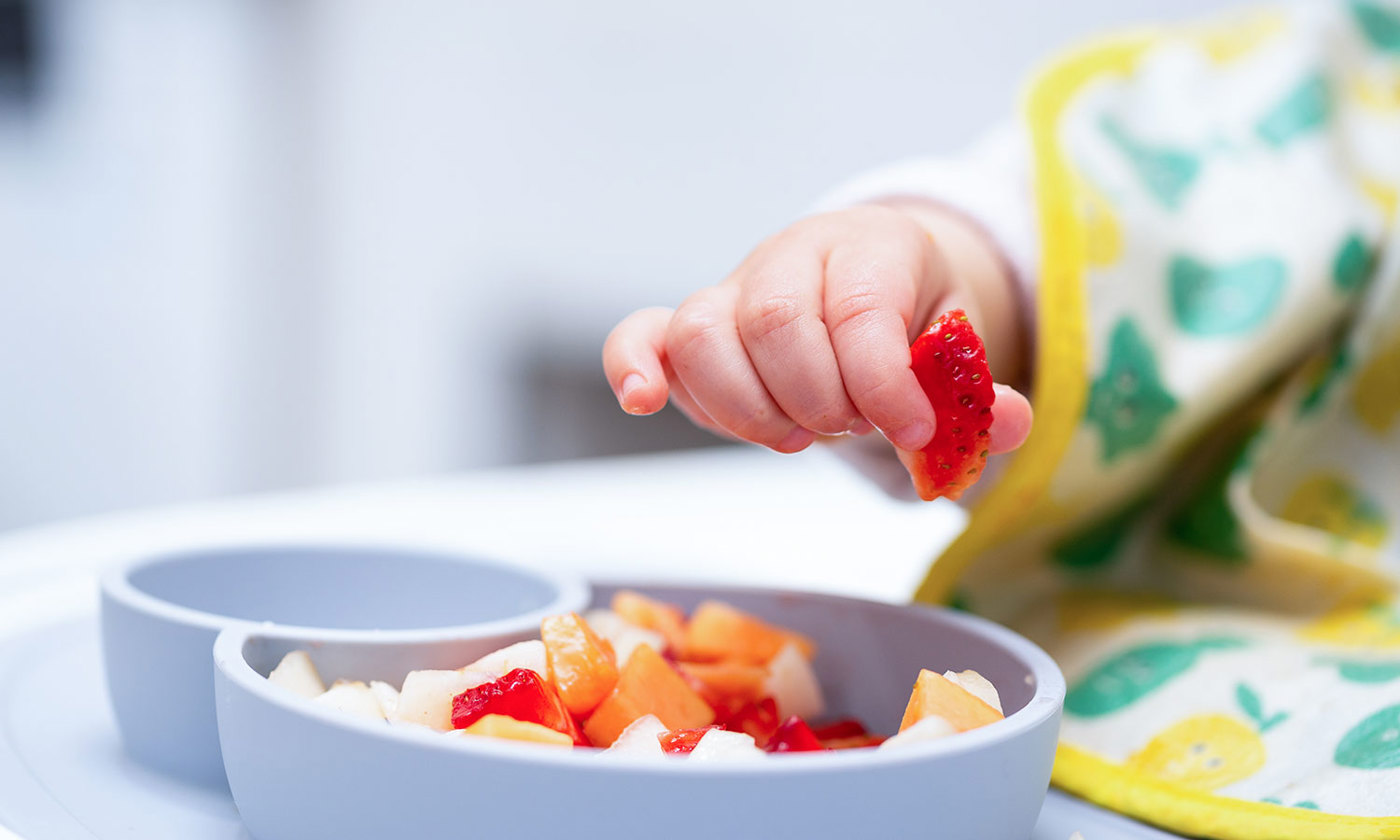Like what you see?
Sign up to receive more free parenting advice.
Thank you for subscribing to our newsletter!
Child Development

Credit: iStock.com/Demianastu
Everything your child eats in the early years will have a major impact on their growth, development and health. So, it’s no wonder parents and carers tread carefully when making choices about the food they prepare.
It can be quite overwhelming to ensure your child manages to get all the nutrients they need. But it’s also a case of “information overload” and it’s easy to get mixed messages.
Nutritionist Nicola Inger Scruby, founder of The Unrefined, says according to the Australian Dietary Guidelines, children (aged 1-3 years) should enjoy a wide variety of nutritious foods from the five food groups.
“But anyone with a toddler knows that sticking to such guidelines can be tricky, particularly when you’re trying to navigate meal-time with a strong willed, fussy two-year-old or ‘threenager'. It’s our responsibility to expose our children to these food groups but not force them to eat,” Nicola says.
“The ‘division of responsibility’ is a term coined by Ellyn Satter. Essentially the term reflects both the child and the parent’s role in feeding. The parent is responsible for what goes on the plate, while the child is responsible for how much.”
When it comes to fussy eaters, Nicola maintains it’s quite normal for a child to be into their food one week and not so into their food the next week.
“Between the ages of one and three a toddler’s appetite begins to slow down as they do not require as many calories as they did in their first year of growth. Repeated exposure helps to make food more familiar and reduces the likelihood of fears and aversion. In fact, evidence suggests that children may need to be exposed to a food more than 20 times before they actually try it!” Nicola says.
Top tips for navigating fussy eating
Here are Nicola’s tips for parents trying to navigate fussy eating:
- When introducing new foods or vegetables, offer at least one food that you know your child likes (aka a “safe” food).
- While it may not always be convenient, try to eat as a family or with your child at least a couple of times per week to model good eating habits.
- Avoid force feeding (putting food into your child’s mouth) as this can cause a negative association.
- Avoid giving your child lots of snacks during the day or before a main meal so they are more inclined to eat their meal.
- Ensure main meals are balanced with macronutrients (a source of protein, healthy fat and carbohydrates) and micronutrients (fruit and vegetables).
- Try to avoid giving your child a “back up food” if they don’t eat what’s in front of them. Simply take the food away, put it in the fridge and re-offer if they are hungry later (always ensuring there is a safe food on your child’s plate).
Nicola says if your child is not meeting their milestones, continually refusing food or seemingly distressed at mealtimes, parents should consult a medical professional, as it could be a sign of an underlying health condition or deficiency.
Understanding salt and sugar
Another issue parents often grapple with is how much salt and sugar to give their child.
Nicola advises parents to limit added salt and added sugars. The recommended dietary intake of sodium for children aged one to three is 200-400mg/day (however, this guideline has not been updated for over a decade and no upper limit has been set).
“According to the 2011-2012 Australian Health Survey, the majority of sodium intake for children aged two years and older was from cereals and cereal products, milk products, processed meats and snack foods. The average sausage from the supermarket can have a range of 400mg-700mg of sodium per sausage! This is why it’s always important to check the nutritional panel and find foods with the lowest salt,“ Nicola says.
“These days, there are a lot of healthy foods and convenience foods with no added sugar. When purchasing convenience snacks for toddlers, look for foods with no added sugar - this includes artificial sweeteners or hidden sweeteners such as corn syrup, dextrose, glucose, maltose, sucrose, fruit juice concentrate, rice malt syrup, evaporated cane sugar, molasses and coconut sugar.
“One teaspoon of sugar is approximately 4g of sugar. When looking at a nutritional panel, I like to divide the sugar content by 4. If it contains more than 1-3 teaspoons of sugar per serve, is not made from real fruit, I reconsider purchasing it. If it’s a one-off treat, I don’t usually check the sugar content!”
The ‘division of responsibility’ is a term coined by Ellyn Satter. Essentially the term reflects both the child and the parent’s role in feeding. The parent is responsible for what goes on the plate, while the child is responsible for how much.Nicola Inger Scruby
Stay up to date with the latest news and articles from First Five Years
Thank you for subscribing to our newsletter!
Understanding a toddler's dietary needs
When referring to Australian dietary guidelines, toddlers 2-3 years should have the following serves from each food group per day:
- 2.5 serves vegetables/legumes (e.g. ½ cup cooked beans, ½ medium potato, ¼ cup green or orange vegetables).
- 1 serve of fruit (e.g. 1 medium banana, apple or orange or 1 cup diced fruit).
- 4 serves of wholegrain foods (e.g. 1 slice of bread, ½ cup cooked rice, ½ cup cooked pasta, 3 wholegrain crackers).
- 1 serve of protein (e.g. 65g meat such as beef, lamb, veal or pork or 80g of chicken/ turkey or 100g cooked fish or 1 cup of canned legumes or beans or 170g of tofu or 2 large eggs or 30g of nuts/seeds or nut seed paste).
- 1.5 serves of dairy or dairy alternatives (e.g. 1 cup of milk and 1 slice of cheese or ¾ cup yoghurt and 1 slice of cheese) .
“However, these expectations can be unrealistic as every toddler’s appetite is different. I recommend caregivers focus on offering 'macro-balanced' meals and snacks. Each snack or meal needs a source of carbohydrate, protein and fat. This helps to stabilise blood sugar and keeps a toddler satiated for longer."
Don't ban or blacklist foods
Nicola doesn’t believe it’s a good idea to ban or “blacklist” certain foods, as this can foster a negative relationship with food.
“You can still say ‘no’ to sweets without causing your child to fixate or obsess over them. Again, reminding your child of the ‘division of responsibility’ can help to navigate situations. For example, if your child is asking for lollies you could say, ‘That sounds great but that isn’t on the menu for snack time. We could add it to snack time tomorrow.’
“This helps set the foundation that parents or caregivers decide what is on the menu and the child decides what to eat from the food provided. Occasionally allowing sweet treats is part of a healthy relationship with food and it is encouraged.”
Part of modern parenting is being exposed to an overload of advice on social media about how to feed your children. While some of this advice can be helpful, Nicola claims there are positives and negatives to this trend.
“It’s great if a person is sharing healthy recipes, without making nutritional claims. However, when seeking nutritional advice for your child, never turn to social media for the answer. Nutrition is very individualised and what works for one child, will not always work for another,” Nicola says.
“Remember that social media is a highlight reel 99 per cent of the time! It is unrealistic to expect your child to eat ‘perfectly’ every day. As long as you’re doing the best you can, you’re doing a great job mama!"
Nicola’s meal ideas:
Breakfast options
- Macro-balanced porridge (oats) with chia, choice of milk, nut or seed butter & fruit.
- Macro-balanced Smoothie with oats or quinoa flakes, leafy greens, ½ banana, berries, choice of milk, yoghurt, nut or seed butter, hemp seeds or chia seeds + piece of toast with spread of choice.
- Scrambled eggs and avocado served with wholegrain or sourdough toast.
Lunch and Dinner options
- Buckwheat or wholegrain pasta spirals with pesto.
- Buckwheat or wholegrain pasta spirals with veggie loaded bolognese.
- Vegetable frittata.
- Meatballs, mash and veggies.
- Egg free savoury veggie muffins.
- Sandwich on whole grain bread with source of protein (tuna, cheese, hummus), fat (avocado, butter).
- Wrap pizza (add tomato, cheese, protein of choice to a wrap and bake in the oven until crispy).
- Dhal with rice.
- Salmon, zucchini and potato fritters.
- Curry and rice.
- Pumpkin and mushroom risotto.
Snacks:
- Dates stuffed with nut or seed butter with half a piece of fruit.
- Banana and nut or seed butter.
- Homemade muffins, banana bread or cookies.
- Store bought wholefood balls (made with dates, seed butter, coconut, chia seeds).
- Cheese and wholegrain crackers.
- Chia pudding with coconut milk & fruit (you can also buy store bought chocolate chia puddings which are a great treat for toddlers with hidden fibre & protein).
- Yoghurt and fruit.
- Veggie sticks and hummus or dip of choice.
- Baked beans.
Nicola Inger Scruby, founder of The Unrefined, is a Nutritionist and mother with a special interest in maternal and infant nutrition. She holds a Bachelor of Business & Advanced Diploma of Health Science (Nutrition) as well as a Masters Certification in Pregnancy, Postpartum & Infant nutrition. Nicola is currently completing further study in Clinical Nutrition and works part-time in a Mother’s wellness centre in Brisbane.







